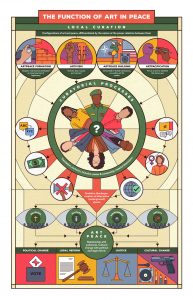
Resources
Art of Peace creates new artists interpretations of the theoretical framework ARTpeace
These illustrations are artists interpretations of the theoretical framework ARTpeace devised by the research team. Artpeace outlines the role or functions arts projects can have on building peace in communities affected by conflict, how they engage with different audiences and outcomes of these projects either because of or in spite of engagement with these audiences.
The theory identifies four types of peacebuilding:
- Artpeace formation: These are organic localised grassroots process.
- Artvism: The art has a cause, is a disrupting force/challenging the status quo.
- Art peace building: These projects form part of an international ‘Western’ formal peacebuilding agenda, supported by external institutions (e.g USA gov/UN).
- Artpacificaiton: This art does not challenge or disrupt but maintains the status quo.
In identifying these four types of arts based peacebuilding, the theory then traces how diverse forms of arts based peacebuilding engage with different audiences or if they are excluded by certain audiences. It talks about how the art may change depending on the audience, who the curator is and the power they hold. It explores how the art reaches different audiences) or why some art is excluded.
In looking at this process of curation, the diagram also examines the results/outcomes of the arts projects and tries to understand what helps and hinders projects. It also looks at how the project has attempted to create alternative space for their art.
Finally, the creation of these spaces, interactions with audiences (international/local/ government/education/cultural/formal/informal/community) can lead to changes in culture (the way people behave or understand the world), political and legal change (law and policy). This is called Artpeace.
Research articles
Reading socio-political and spatial dynamics through graffiti in conflict-affected societies
This paper argues that graffiti can provide a form of socio-political commentary at the local level, and is a valuable, yet often overlooked, resource for scholars and policymakers in conflict-affected societies. Graffiti, in its many forms, can provide rich insight into societies, cultures, social issues, trends, political discourse, and spatial and territorial identities and claims.


